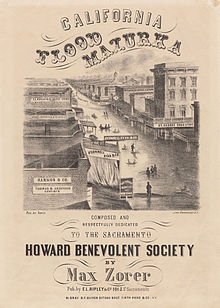begin quote from:
https://en.wikipedia.org/wiki/Great_Flood_of_1862#Northern_California
Two years later William H. Brewer saw near Crescent City, the debris of the flood:
Central Valley[edit]
The entire Sacramento and San Joaquin valleys were inundated. An area about 300 miles (480 km) long, averaging 20 miles (32 km) in width,[18] and covering 5,000 to 6,000 square miles (13,000 to 16,000 km2) was under water.[12] The water flooding the Central Valley reached depths up to 30 feet (9.1 m), completely submerging telegraph poles that had just been installed between San Francisco and New York. Transportation, mail, and communications across the state were disrupted for a month.[19] Water covered portions of the valley from December 1861, through the spring, and into the summer of 1862.[12]
In Knight's Ferry, in the foothills of the Sierra Nevada astride the Stanislaus River, about 40 miles (64 km) east of Modesto, the town's homes, its mill, and most of its businesses were ruined by the flood. The bridge spanning the river initially withstood the flood waters but was destroyed when the debris of the bridge at Two-Mile Bar, only a short distance up river, torn from its foundation, crashed into the Knights Ferry Bridge, crushing the truss supports and knocking it from its rock foundation.[20] All Sacramento, excepting one street, part of Marysville, part of Santa Rosa, part of Auburn, part of Sonora, part of Nevada City, and part of Napa were under water.[21] Some smaller towns like Empire City and Mokelumne City were entirely destroyed.
Sacramento[edit]
Sacramento, sited at the junction of the Sacramento and American Rivers, was originally built at 16 feet (4.9 m) above low-water mark, and the river usually rose 17 to 18 feet (5.2 to 5.5 m) almost every year. The New York Times reported on January 21, 1862 that a trapper who had spent more than 20 years in California had frequently boated over the city's site, and in 1846, the water at the location was 7 feet (2.1 m) deep for sixty days.[21] On 27 December 1861, the Sacramento River reached a flood level of 22 feet 7 inches (6.88 m) above the low water mark, after rising 10 feet (3.0 m) during the past 24 hours.[12]
The Sacramento flood plain quickly became inhabited by a growing population during the Gold Rush and served as the central hub for commerce and trade and the home of political leadership, the California State Legislature. The landscape was recognized as a flood-prone landscape located at the confluence of the American and Sacramento River. John Muir noted the extent of seasonal flooding in Sacramento, "…The greatest floods occur in winter, when one could suppose all the wild waters would be muffled and chained in frost and snow…rare intervals warm rains and warm winds invade the mountains and push back the snow line from 2000 to 8,000 feet, or even higher, and then come the big floods."[22]
However, the series of storms that led to the Great Flood of 1862 averaged precipitation levels that records show only occur once every 500 to 1,000 years.[23] The geographical range of flooding in the state was noted by a traveling geologist from Yale University, William Brewer, who wrote that on January 19, 1862,
From December to January 1862 the series of storms carrying high winds and heavy precipitation left city streets and sidewalks underwater. Photographs show canals in place of city streets and boats docked to storefronts.[24]
On Inauguration Day, January 10, 1862 the state's eighth governor, Leland Stanford, traveled by rowboat to his inauguration building held at the State Legislature office. Much of Sacramento remained under water for 3 months after the storms passed. As a result of flooding, the California State Legislature was temporarily moved to San Francisco during rebuilding and renovating the sunken city of Sacramento.

No comments:
Post a Comment